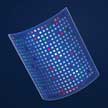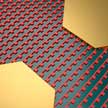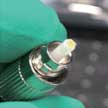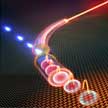Showing Spotlights 41 - 48 of 158 in category All (newest first):
 Electronic device versions of the human eye's photoreceptors could potentially be used in a wide range of applications from robotic humanoid vision to artificial retina implantation for vision restoration or even vision extension into a wider range of wavelength. Researchers have now demonstrated that high-performance filterless artificial human photoreceptors can be realized by integrating a novel optical metal/dielectric/metal microcavity structure with vacuum-deposited perovskite photoresponse devices. These easy-to-fabricate artificial photosensors mimic the spectral responses of human color cones and rods.
Electronic device versions of the human eye's photoreceptors could potentially be used in a wide range of applications from robotic humanoid vision to artificial retina implantation for vision restoration or even vision extension into a wider range of wavelength. Researchers have now demonstrated that high-performance filterless artificial human photoreceptors can be realized by integrating a novel optical metal/dielectric/metal microcavity structure with vacuum-deposited perovskite photoresponse devices. These easy-to-fabricate artificial photosensors mimic the spectral responses of human color cones and rods.
May 1st, 2019
 Researchers demonstrate, for the first time, a tellurium@selenium (Te@Se) heterostructure used as a working material in a photoelectrochemical-type photodetector. Specifically, Te@Se nanotube heterojunctions synthesized by epitaxial growth of selenium on tellurium nanotubes exhibit a largely enhanced self-powered photoresponse, significantly improved photocurrent density, and photoresponsivity compared to those of Te or Se nanomaterials.
Researchers demonstrate, for the first time, a tellurium@selenium (Te@Se) heterostructure used as a working material in a photoelectrochemical-type photodetector. Specifically, Te@Se nanotube heterojunctions synthesized by epitaxial growth of selenium on tellurium nanotubes exhibit a largely enhanced self-powered photoresponse, significantly improved photocurrent density, and photoresponsivity compared to those of Te or Se nanomaterials.
Apr 25th, 2019
 Terahertz (THz) frequencies, which occupy a middle ground between microwaves and infrared light, are seen as the future of wireless communications because they offer a higher bandwidth capacity for data transmission than currently used microwave radiation. Researchers have improved the photoconductive switch, a key optoelectronic element in THz technology, with a perfectly-absorbing photoconductive metasurface. The perfect absorption within this metasurface allows to make the active region of THz wave detectors significantly thinner in comparison to conventional detectors. Apart from reducing the size of THz detectors, it also improves their efficiency.
Terahertz (THz) frequencies, which occupy a middle ground between microwaves and infrared light, are seen as the future of wireless communications because they offer a higher bandwidth capacity for data transmission than currently used microwave radiation. Researchers have improved the photoconductive switch, a key optoelectronic element in THz technology, with a perfectly-absorbing photoconductive metasurface. The perfect absorption within this metasurface allows to make the active region of THz wave detectors significantly thinner in comparison to conventional detectors. Apart from reducing the size of THz detectors, it also improves their efficiency.
Apr 24th, 2019
 Polymer composite films, particularly those based on polymers and layered nanomaterials, are attractive materials for exploiting the properties of multiple materials for applications in electronics and photonics. Recently, scientists have found that beta-lead oxide quantum dot /polystyrene composite films exhibit excellent stability in high humidity and strong saturable absorption response from visible to the near-infrared region. This makes them an attractive material for practical applications in optoelectronic devices in marine environments and other harsh condition, such as humid weather.
Polymer composite films, particularly those based on polymers and layered nanomaterials, are attractive materials for exploiting the properties of multiple materials for applications in electronics and photonics. Recently, scientists have found that beta-lead oxide quantum dot /polystyrene composite films exhibit excellent stability in high humidity and strong saturable absorption response from visible to the near-infrared region. This makes them an attractive material for practical applications in optoelectronic devices in marine environments and other harsh condition, such as humid weather.
Apr 8th, 2019
 In recent years, all-optical modulators (AOMs) have attracted significant interests due to their low power consumption, broad bandwidth, and potential in all-optical fields. Among these, AOMs based on the high photothermal efficiency of antimonene, exhibit remarkable advantages for their large modulation depth, wide operating wavelength range, and easy implementation.
Researchers demonstrated that an antimonene-based AOM was successfully utilized to actively Q-switch a fiber laser in a fully photonics domain and this actively modulated laser represented all-optically tunable output parameters, and easy time synchronization.
In recent years, all-optical modulators (AOMs) have attracted significant interests due to their low power consumption, broad bandwidth, and potential in all-optical fields. Among these, AOMs based on the high photothermal efficiency of antimonene, exhibit remarkable advantages for their large modulation depth, wide operating wavelength range, and easy implementation.
Researchers demonstrated that an antimonene-based AOM was successfully utilized to actively Q-switch a fiber laser in a fully photonics domain and this actively modulated laser represented all-optically tunable output parameters, and easy time synchronization.
Mar 15th, 2019
 Scientists have experimentally realized a plasmonic aerosol by efficiently transitioning liquid suspensions of gold nanorods into the gas phase and simultaneously measuring their optical spectra. They demonstrated that these aerosols are optically homogeneous, thermodynamically stable, with wide wavelength tunability (by controlling the aspect ratio of the nanorods) and have extremely large sensitivities to their environment. This novel plasmonic material could potentially open the door to many interesting applications ranging from geoengineering, vacuum microelectronics, molecular diagnostics, nanomedicines, nanojet printing and nonlinear optics.
Scientists have experimentally realized a plasmonic aerosol by efficiently transitioning liquid suspensions of gold nanorods into the gas phase and simultaneously measuring their optical spectra. They demonstrated that these aerosols are optically homogeneous, thermodynamically stable, with wide wavelength tunability (by controlling the aspect ratio of the nanorods) and have extremely large sensitivities to their environment. This novel plasmonic material could potentially open the door to many interesting applications ranging from geoengineering, vacuum microelectronics, molecular diagnostics, nanomedicines, nanojet printing and nonlinear optics.
Mar 6th, 2019
 Researchers demonstrate a display pixel that can switch on and off at least 1000 times faster than pixels that use conventional liquid crystal materials. They show that plasmonic gold nanorods - which interact very strongly with light - can be aligned using electric fields, and they use this alignment to control the amount of light that can pass through the pixel. By engineering the dimensions and material structure of the nanorods, the scientists design pixels that work with different colors of light, both visible and infrared.
Researchers demonstrate a display pixel that can switch on and off at least 1000 times faster than pixels that use conventional liquid crystal materials. They show that plasmonic gold nanorods - which interact very strongly with light - can be aligned using electric fields, and they use this alignment to control the amount of light that can pass through the pixel. By engineering the dimensions and material structure of the nanorods, the scientists design pixels that work with different colors of light, both visible and infrared.
Mar 4th, 2019
 Researchers report an interesting phenomenon of two-dimensional (2D) hexagonal boron nitride (h-BN)-induced planar-alignment of a nematic liquid crystal and the subsequent optical and electro-optical effects. Liquid crystals (LCs) are optically anisotropic materials, and they are widely used in electro-optical display technology, known as liquid crystal displays (LCDs). Understanding the alignment phenomena of a nematic LC on a surface remains an important area of research, as the alignment process determines the LC's molecular orientation and conformation - which influence the LC's optical and electro-optical characteristics in LCDs.
Researchers report an interesting phenomenon of two-dimensional (2D) hexagonal boron nitride (h-BN)-induced planar-alignment of a nematic liquid crystal and the subsequent optical and electro-optical effects. Liquid crystals (LCs) are optically anisotropic materials, and they are widely used in electro-optical display technology, known as liquid crystal displays (LCDs). Understanding the alignment phenomena of a nematic LC on a surface remains an important area of research, as the alignment process determines the LC's molecular orientation and conformation - which influence the LC's optical and electro-optical characteristics in LCDs.
Jan 9th, 2019
 Electronic device versions of the human eye's photoreceptors could potentially be used in a wide range of applications from robotic humanoid vision to artificial retina implantation for vision restoration or even vision extension into a wider range of wavelength. Researchers have now demonstrated that high-performance filterless artificial human photoreceptors can be realized by integrating a novel optical metal/dielectric/metal microcavity structure with vacuum-deposited perovskite photoresponse devices. These easy-to-fabricate artificial photosensors mimic the spectral responses of human color cones and rods.
Electronic device versions of the human eye's photoreceptors could potentially be used in a wide range of applications from robotic humanoid vision to artificial retina implantation for vision restoration or even vision extension into a wider range of wavelength. Researchers have now demonstrated that high-performance filterless artificial human photoreceptors can be realized by integrating a novel optical metal/dielectric/metal microcavity structure with vacuum-deposited perovskite photoresponse devices. These easy-to-fabricate artificial photosensors mimic the spectral responses of human color cones and rods.
 Subscribe to our Nanotechnology Spotlight feed
Subscribe to our Nanotechnology Spotlight feed





